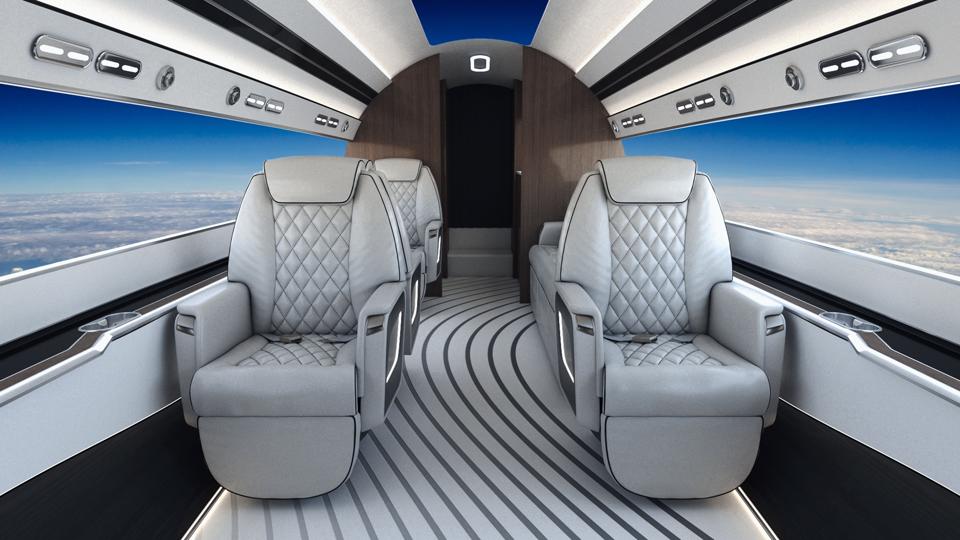Flexjet is making its second massive order for new private jets this year. It follows its $7 billion order with Embraer back in February. The first new aircraft from that order is expected to reach the NetJets rival early next year. Whether any of the 300 windowless Phantom 3500s the company is ordering from Otto Aerospace ever enter service is more of an open question.
The Phantom 3500 is not related to the similar sounding Phenom 300 from Embraer or Bombardier’s Challenger 3500. It will mark the debut of Otto Aerospace, which says the Phantom 3500 will offer “revolutionary aerodynamic efficiency unlocks performance metrics never before seen in similar aircraft.”
The announcement describes the Phantom 3500 as “a clean-sheet, ultra-efficient aircraft that leverages breakthrough laminar-flow aerodynamics and precision all-carbon-fiber composites to cut fuel burn by over 60%.”
Traditional windows in the passenger cabin are replaced with high-definition digital displays that integrate real-time external views.
Flexjet, Inc. Chairman Kenn Ricci says “For 30 years, Flexjet has led through innovation opposed to imitation, introducing tomorrow’s standards, not reacting to yesterday’s expectations,” adding, “The Phantom 3500 exemplifies that approach perfectly, marking a bold step into a future where an aircraft’s efficiency and sustainability stand alongside speed, comfort and range as defining standards.”
He adds, “This collaboration with Otto Aerospace further affirms our leadership role in delivering to fractional aircraft owners the future of luxury private aviation.”
While the list price for the new business jet hasn’t been released, a July report from Corporate Jet Investor said the Phantom will be “50% less to purchase and to operate than current midsize business aircraft.”
A report by The Wall Street Journal, which broke the news, pegs the order value at $5.85 billion, which equates to a $19.5 million list price.
In terms of its positioning, the aircraft will compete in the super-midsize category. It promises a stand-up cabin six feet, five inches tall with a range of 3,200 to 3,500 nautical miles. It would need a runway length about 30% shorter than prospective rivals if it lives up to its claims. It will also be fast, flying at transonic speeds. The company selected the FJ44-4 QPM turbofan engine from Williams International as its powerplant.
The Phantom 3500 will go against Embraer’s Praetor 600, the Challenger 3500, and Gulfstream G280. Its specifications would make it a good fit for transcontinental flights, from the West Coast to Hawaii and from the Northeastern U.S. to the deep Caribbean.
Otto Aerospace CEO Paul Touw said, “Flexjet’s decision to build their fleet around the Phantom 3500 speaks volumes about where aviation is headed. As one of the largest business jet orders in private aviation history, this marks a turning point in the industry’s move toward sustainable and efficient air travel.”
He added, “The Phantom 3500 will redefine private aviation, providing Flexjet with a fleet that dramatically reduces costs while expanding operational capabilities and enhancing the customer flying experience.”
For Flexjet, the order also aligns with Ricci’s profile, focusing on taking a different road. His first major play was Flight Options in the late 1990s, which challenged NetJets by offering shares in pre-owned private jets. That original platform became the foundation for today’s Flexjet, which he acquired from Bombardier in 2013.
The fractional flight provider’s over 60 different design-led cabin interiors are counter to the normal approach of standardizing as much as possible to cut costs. Its LXi interiors are meant to appeal to UHNWs who value the small details.
In 2015, Ricci placed a firm order for 20 Aerion Corp.’s AS2, a planned supersonic business jet. NetJets followed suit in March 2021, only to see Aerion shutter several months later.
In 2021, Flexjet ordered 200 eVTOLs from Eve Urban Mobility Solutions as part of its commitment to providing customers with a last-mile solution.
While it has been building out its fleet of twin-engine luxury Sikorsky helicopters, Ricci recently told Newsweek he wasn’t sure the battery-powered eVTOLs will be a fit for wealthy flyers. He said of the next-generation rotorcraft, “They’re very well suited for freight, for blood transfer, for health care, for organs.”
In June, Florida Governor Ron DeSantis announced a package of $500 million in incentives during the Paris Air Show, which will see Otto relocate from Texas to Jacksonville, where it will manufacture the Phantoms, creating 389 jobs, according to Aviation International News.
Flexjet already operates the Praetor 500, a long-range, stand-up cabin midsize jet, as well as the Praetor 600 and Challenger 3500. It then goes to the long-range, large cabin Gulfstream 450. Earlier this month is introduced its first G700 alongside its G650s.
For Touw, he is no stranger to private jet fleet operators, having founded XOJET. Back in 2007, he placed a firm order for 20 of the Challenger 3500’s predecessor, the Challenger 300, along with options for 60 more. At the time, he said of what looks to be his prime competitor, “Bombardier’s process for designing the Challenger 300 was without precedent. The result is one of the most popular business jets ever introduced.”
Will Otto’s 3500 best Bombardier’s 3500? The first flight of the Phantom 3500 is planned for 2027, with entry into service scheduled for 2030.
A Flexjet spokesperson says, “Terms of the deal were not disclosed, but include a firm order for 300 Phantom 3500 business jets with additional options. The agreement also grants Flexjet’s in-house maintenance organization the ability to become an Otto authorized service center.”

